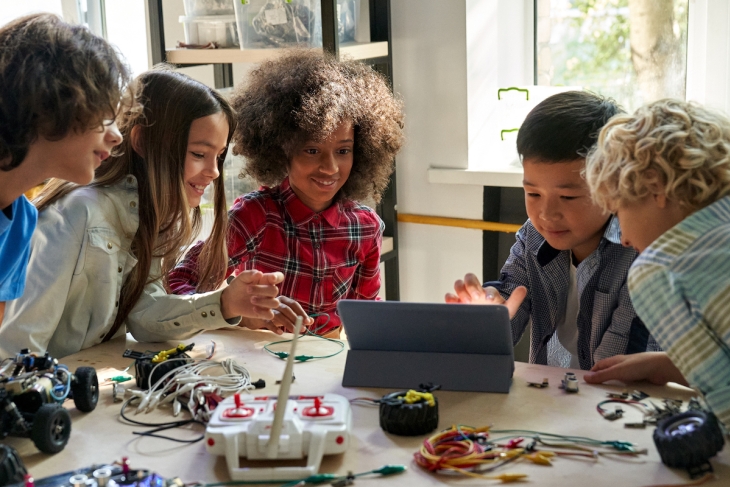Imagine the course of history if some of the most brilliant minds were held back by learning disabilities. Albert Einstein was dyslexic and didn’t talk until he was six. His teachers said nothing good would come of him. Thomas Edison was called “too dumb.” He was kicked out of school at age twelve because he struggled with mathematics and had difficulty speaking and pronouncing words. Yet each overcame struggles, and their scientific discoveries and inventions impact our lives still today.
Einstein and Edison are exceptional, but not completely unique. Many children today experience learning challenges, like dyslexia, attention deficit hyperactivity disorder (ADHD), dyscalculia, autism, or sensory processing issues, and are also highly gifted in math, science, writing, or music. These children—“twice exceptional” or 2e—comprise one of the most under-identified and misunderstood populations in education.
Identifying the 2e child
More than one-third of gifted students could be 2e, research suggests. Unfortunately, the true number is difficult to pinpoint. Often these children’s strengths obfuscate their struggles, making learning challenges harder to diagnose. On the flip side, learning disabilities may disguise a child’s giftedness. Even more frequently, neither the disability nor the giftedness is recognized.
The reason: 2e children think and process information differently. They have exceptional critical thinking and problem-solving skills, a strong curiosity, and the ability to concentrate deeply on topics that interest them. However, they tend to be more emotionally and intellectually sensitive. With asynchronous development and learning differences, these students struggle with tasks or subjects that other children may handle easily. 2e children also can be prone to poor social skills, low self-esteem, and behavioral problems stemming from underlying stress, boredom, and lack of motivation.
For example, Jane is a highly gifted dyslexic student. Her school district requires cut-off scores in each category for gifted identification, which Jane does not meet. When academic achievement scores are part of this calculus, students who experience learning challenges could be easily overlooked. However, if the district created a framework in which students can “qualify” in many areas, such as curriculum, leadership, artistic ability, or creativity, rather than limiting qualification areas to core academic content areas, gifted programs are more likely to capture students like Jane.
2e children typically fall into one of three existing categories, according to the National Association for Gifted Children:
- Gifted without identified disability: These students are often considered underachievers and perceived as lazy or unmotivated. They go unnoticed for possible special education evaluation because they achieve at grade level until the curriculum becomes more challenging in middle and high school.
- Identified learning disability, but not tested as gifted: These students typically participate in special ed programs. Because they have not been assessed for intellectual abilities, they may become bored if not adequately challenged.
- Not formally identified as gifted or learning disabled: These students achieve at grade level and are assumed to have average ability, yet they struggle with increasingly difficult curriculum. They would never be referred for special education evaluation based on standardized test scores or underachievement.
Many factors must be considered when classifying a student’s giftedness or learning disability. A neuropsychological evaluation is a comprehensive way to determine a student’s cognitive and academic strengths and weaknesses. When that is not possible, the Davidson Institute offers steps to identify 2e students who may need special support:
- Use a multi-dimensional approach with both formal and informal assessments, including written tests and behavioral assessments. Assessment procedures also should accommodate language and cultural differences to avoid bias in the identification process.
- Separate out test scores on IQ tests since most 2e children are inconsistent performers with uneven skills and asynchronous development.
- Reduce qualifying cut-off scores to account for learning differences or disabilities.
- Consider oral questioning, instead of formal written testing, if the student experiences difficulties with processing details.
- Extend the time available for the student to demonstrate their knowledge.
Unique support needed for unique students
Placing 2e students in existing gifted programs or providing targeted special education is simply not sufficient. 2e students require a learning environment that can address both their giftedness and disability, and provide support needed to reach their full potential.
The key is collaboration among gifted education, special education, and counseling professionals to develop an individualized, strength-based program that considers the whole child. It should be designed to cultivate the individual 2e student’s interests and talents, accommodating both academic strengths and weaknesses. Special attention should also be paid on student’s social and emotional development. Students should have opportunities to participate in enrichment activities and experiences, both inside and outside of the classroom, as well.
Because each 2e child has their own unique abilities and characteristics, they do not fit neatly into established gifted and special education categories. By taking the steps to identify these children, and providing the support they need, educators can help 2e students blossom in the classroom and unlock the full promise of their exceptional talents.




